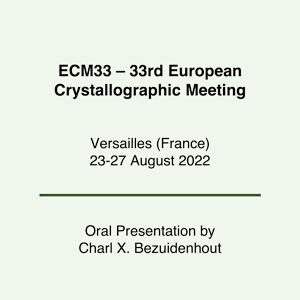Versailles (France), 23-27 August 2022, Oral Presentation by Charl X. Bezuidenhout
Title: “Cooperative dynamics in metal–organic frameworks: from free-and-isolated to interacting synchronous rotors “
Authors: C. X. Bezuidenhout, J. Perego, S. Bracco, P. Sozzani and A. Comotti
Abstract
Owing to their modular nature, Metal-Organic frameworks (MOFs) represent a new platform for achieving and exploring structural framework that allows for control over the ligand environment. This allows for tuning of the ligand properties towards potentially desired outcomes. Traditionally when inserting molecular rotors as struts into MOFs, the gaol is to isolate them and consequently lowering their reorientation energy barriers for fast rotary dynamics. We have achieved such a system of isolated bicyclo[1.1.1]pentandioate (FTR) rotors within a MOF structure which yielded an energy barrier for rotation of a couple calories per mole. [1] The outstanding synthetic versatility of MOFs allows us to insert the FTR rotor into a pillar-and-layer Zn-MOF where the rotors can interact with their neighbours (Fig 1 and 2). Contrary to expectations, these rotors navigate the rotational potential energy landscape in such a way to produce co-rotating pairs of rotors or geared molecular rotors. These geared molecular rotors have a very low energy barriers for rotation (24 cal/mol) owing to the synchroneity of their rotation. Additionally, the collective bipy-ring rotation are in concert with the framework structural dynamics that gives rise to controllable swinging between two identical arrangements in a dynamically disordered structure. Upon cool down to 160 K the framework become more ordered thus indicating that the reorientation dynamics of the bipy pyridyl rings are being stopped. This framework gymnastics is a good example of structural dynamics controlled by rotor reorientation dynamics. [2] References [1] J. Perego, S. Bracco, M. Negroni, C. X. Bezuidenhout, G. Prando, P. Carretta, A. Comotti, P. Sozzani Nature Chem. 2020, 12, 845. [2] J.Perego, C. X. Bezuidenhout, S. Bracco, G. Prando, L. Marchiò, M. Negroni, P. Carretta, P. Sozzani, and A. Comotti Journal of the American Chemical Society 2021,143 (33), 13082-13090.

